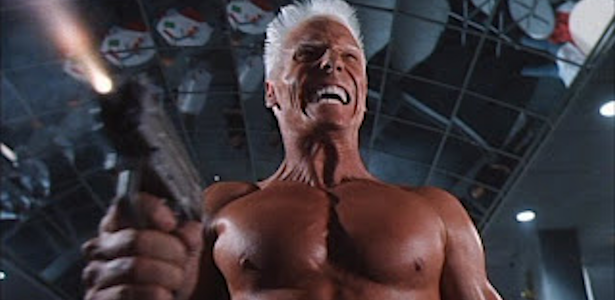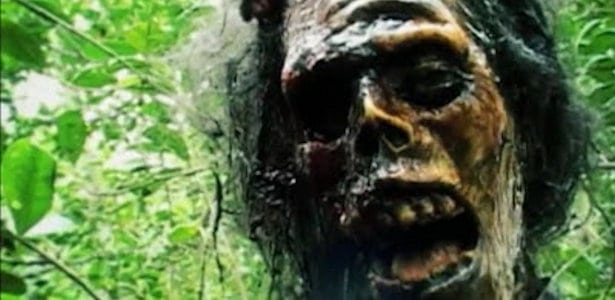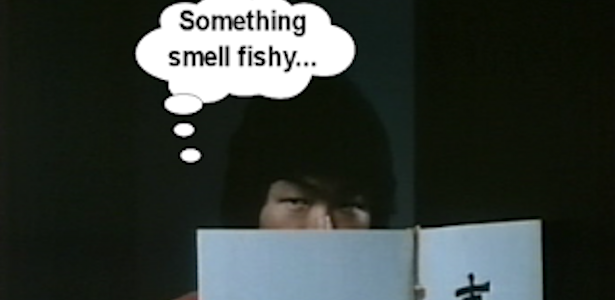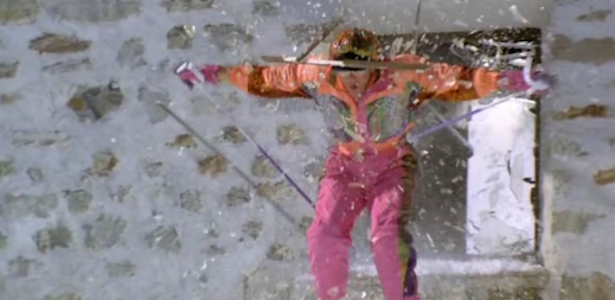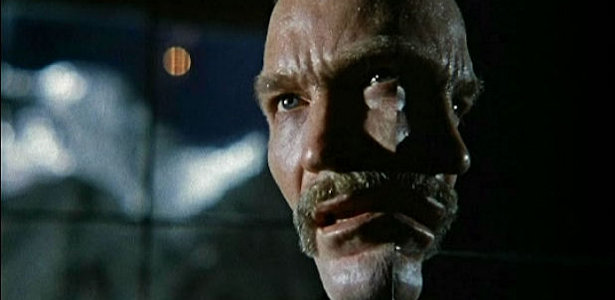Born from the popular disaster subgenre that popped up in the early 1970s, Universal’s EARTHQUAKE follows the pattern of the same studio’s AIRPORT (1970) – the granddaddy of this catastrophe cycle – by featuring an all-star cast. The poster teased audiences with named like Charlton Heston, Ava Gardner, George Kennedy, Lorne Greene, Genevieve Bujold, Richard Roundtree, and Walter Matuschanskayasky. Okay, maybe not that last guy (Walter Matthau's pseudonym for his cameo). Ordinary folks would pay to see this ensemble play ordinary folks who must fight the odds during a natural disaster that rips Los Angeles apart. In addition to the big name cast, the poster simply promised audiences “An Event…” that would be presented in Sensurround, a new, cutting edge sound technology developed specifically for this film.
EARTHQUAKE was originally announced in September 1971. Universal was hoping to recreate the success of the previous year’s AIRPORT and the perfect plot fell in their lap in early 1971 with the San Fernando earthquake. I can see some bleary-eyed Universal exec being jolted awake in their waterbed and – following the quake’s 60 second 6.6 magnitude rumbling – going “I got it!” Initially director John Sturges, fresh off ICE STATION ZEBRA (1968) and MAROONED (1969), and screenwriter Mario Puzo, having adapting his book into some obscure movie called THE GODFATHER (1972), were attached to the project. Something happened along the way to Puzo’s career (wink, wink) and he only wrote two drafts before leaving. He was replaced by a mysterious George Fox, who received co-writing credit with this being his only screenwriting credit. Read into that what you will. Along the way, Sturges left and veteran director Mark Robson signed on in October 1973. The aforementioned cast was quickly assembled and the film went into production in early 1974, making its November 1974 release date with ease. The film was an instant success as it managed to shake $79,666,653 from U.S. audiences’ wallets, making the film the 6th highest grossing film at the box office that year. Adjusted for inflation, that figured would be
$338,056,400 in 2012 dollars. Not bad for a film that cost an estimated $7,000,000 (which would be roughly $30,000,000 today; not that Hollywood could control itself if they made a film like this nowadays).
As with our previous editing examination entry
TWO-MINTUE WARNING (1976), EARTHQUAKE (1974) also benefitted from studio reshoots in order to expand the film for its network television debut. During the summer of 1976, Gene Palmer (Robson refused to participate) shot several new scenes to add an additional 20 plus minutes of footage so that the film could unspool over two nights for NBC on their “The Big Event,” the network’s rebrand/replacement of the NBC Mystery Movie. The film debuted in two parts on Sunday, September 26, and Monday, September 27. Ever the thinkers, NBC also played the Sensurround audio on an FM channel in the Los Angeles and New York markets. As it had at the box office, EARTHQUAKE rattled audiences again. According to the September 29, 1976 issue of Variety, the 90-minute first entry of the film pulled in an astounding 41 share of the television audience. No doubt a majority of that crowd tuned in to see the further adventures of Jody Joad (Marjoe Gortner), one of the beneficiaries of the new footage.
The television version kicks off with new footage right away as aerial footage of the San Andreas Fault is shown. Running a minute and twenty seconds, the footage is accompanied with a doom and gloom voiceover that informs and warns viewers about the potential of earthquakes.
“Virtually the entire Pacific coast of our hemisphere rests on a series of geologic faults. One of the most unstable of these is the San Andreas Fault, running 600 miles through the state of California. Some sections of the fault are slipping. The two sides are sliding past each other slowly. The strains accumulating are being dissipated rather harmlessly without generating large earthquakes. At two points, however, the sides of the Fault are locked, permitting no slippage. Elastic strain energy is being built up. Invisibly, the land is being compressed and warped, storing energy like a colossal spring under the crust of the earth. Many scientists feel this energy will break loose and a cataclysmic earthquake will occur within the next decade. Others feel it can happen tomorrow. One of the critical points is north of San Francisco, the other just a few miles east of Los Angeles.”



Surprisingly, not a lot of footage is cut from the theatrical version of the film. Before any new footage shows up, there are a few small alterations. The first excision is a 20 second scene that shows Denise Marshall (Genevieve Bujold) at home with her son just before creepy old man Stewart Graff (Charlton Heston) shows up. She tells him to get ready for school and the young boy leaves the kitchen and is quickly shown going to fix his bed.

Perhaps more interesting are the edits relating to Lou Slade, the police officer character essayed by George Kennedy. In the first half hour, several scenes that show him in a negative light are removed. First, his disciplinary hearing removes him telling his superior that the officer he punched out earlier was a “peckerwood rich man’s whore.” Later, there is a 40 second scene where Jody is annoyed at some Harikrishnas outside of his grocery store and asks Slade to get rid of them. The bitter cop responds, “You got something against religion?” and leaves.





The other removal happens a few scenes later and involves Slade breaking up a bar fight by throwing one dude into a row of cues on the wall. Police brutality, yes! Slade says the shot counted (the fight started because a tremor had moved the ball) and then resumes his place at the bar. The drunk at the end of the bar (Walter Matthau) raises his shot glass and mumbles, “Bobby Riggs” (the U.S. tennis player) to which Slade agrees with a nod and takes a drink. So the TV version wants us to think Irish cops don’t fight and drink. Riiiiight.



The first major bit of new footage appears around the 28 minute mark in the television version. After the scene where the folks at the dam notice the water level is rising, we are introduced to newlyweds Tony (Sam Chew) and Kathie (Debralee Scott) on a plane flight to Los Angeles. By sheer coincidence (or lazy screenwriting), Tony is on his way to interview with Graff’s architecture firm and he is boning up by reading a mag with Heston’s picture on the front.
Man, he is really into that magazine. Gee, I wonder what the centerfold looks like?
We cut to the captain (Frank Parker) and his crew and he mentions that they are passing over the Grand Canyon and that he’ll turn the plane to the right so everyone can see (amusing, the filmmakers then show a POV inside a cockpit and the plane tilts to the left). As the pilot gives some info, Kathie looks out the window bored.
Kathie doesn’t seem too happy to be moving to L.A. and she certainly doesn’t approve of Tony’s man crush (“Ever since we’ve been married, all you do is talk or read about that man. It’s like I don’t even exist.”) Anyway, this marriage is the definition of opposites attract as his wife wants to read his future (with a deck of playing cards!). Naturally, she sees bad things in the future and even says “there is danger to travel at this time, possibility of death” (no joke, accompanied by a loud piano sting).
The Ace of Spades! The Ace of Spades!
A few scenes later the TV version eliminates a 32 second scene with Graff drinking with his paramour Denise. They open a bottle of wine and he mentions about what he will tell his wife. Amusingly, they cut this out but leave in the next scene where she talks about how angry Graff was when he made love to her. Drinking, bad. Angry sexing, good.

At the 45-and-a-half minute mark, the TV version offers its biggest expansion in a nearly 7 minute scene involving Jody and his obsession with motorcycle chick Rosa Amici (Victoria Principal). In the theatrical release version, Jody has just left his store for National Guard duty while Rosa has left her brother Sal (Gabriel Dell) and daredevil Mile Quade (Richard Roundtree) after wanting no part of their crazy motorcycle stunt. They dub in the new line “I’m going home to change into some fresh duds.” In the newly shot footage, she is at home after taking a shower. Jody shows up and proceeds to be the worst stalker ever as he laughably peeps in full view in front of a full length window.







Oh yeah, those fresh duds she was changing into? The same outfit she had on before. Not that I am complaining about Principal in that top. Jody finally gets up the nerve to knock on the door. She thinks he’s there to collect the money from her grocery bill that he let her out of earlier, but Jody says the National Guard has been called up and he just wanted to check to see if she is okay. Despite being creeped out, she invites him in (!), allowing him to get his major creep on. When she asks how he knew where she lived (shouldn’t you ask that before he comes in?), he says, “I followed you home at night just to make sure you got home safely.” Red flag no. 1! He then proceeds to tell her that her place isn’t very neat and “my mother wasn’t either.” Jesus! Red flag the size of Texas there! She then says, “Look, I was going to go to a movie. You want to go with me?” GOOD GOD! Chicks love them bad boys. He declines (what kind of stalker is this dude?), but places her in a chair and says, “You just stay right here.”







This Jody/Rosa footage has created some confusion in viewers over the years, with some folks theorizing it was left on the cutting room floor of the initial production. That is not the case as this was shot exclusively for the TV version. You can tell because it is very flatly shot (unlike the rest of EARTHQUAKE), it isn’t subtle at all (note the picture of Sal on Rosa’s wall), and Principal is wearing a similar but different wig. To confuse you even more, there is a deleted scene from the original later where Rosa is heading to the movies and a biker (Reb Brown) asks if she wants a ride. She says no and hops on a bus.
On his way home, Jody stops to admire a burning building and remarks at how beautiful it is. Okay, we get it, he’s wacko! One guy watching says, “We’ll probably have more fires from the aftershocks” to which one old man says, “Boy, I hope not.”
Jody heads home and we return to the theatrical cut, but the TV folks remove the line when the three guys harassing him call him a fag (more on that later). Immediately following this scene, the next small removal from the theatrical version is a 48 second scene of Graff in his office talking to a potential client about earthquake safety regulations. This fat cat doesn’t want to spend the money, but Graff tells him he must. This guy is the one who later throws the woman out of the elevator before it freefalls to the ground. Things to glean from EARTHQUAKE: if you try to cut corners on safety regulations, you will die!

Next up is a removal that I 100% disagree with. The TV version takes out the bit where Miles botches his first attempt at the loop jump. When the film was shot, the stuntman didn’t complete the loop and it resulted in a spectacular looking crash. Never ones to pass up a good moment, the filmmakers worked it into the final film. In a movie filled with jaw dropping moments, this might be the best. Network viewers never knew what they were missing.
At the 57 minutes and 30 seconds mark, we return to the plane for a short 50 second scene. It just has the pilots talking to the air traffic control tower and getting their landing coordinates.
Just before the big one hits, we get the last major removal of any scenes from the theatrical version. When Graff meets up with his wife Remy (Ava Gardner), the scene of them arguing inside the elevator is removed. It is pretty obvious why as she claims he has been seeing “that Marshall bitch” and then calls him a “bastard.” Damn, Remy got a mouth on her. Is it just a coincidence that seconds after she bitches him out the ground starts shaking and cracking open?
At the one hour mark, we get another new plane scene as the passengers are told to fasten their seatbelts and the captain calls the LAX tower to confirm their approach.
When the earthquake finally arrives, the events basically unfold as they do in the theatrical version. However, after the chaos scene in Graff’s office (it should be noted the cartoon blood splash in the crashing elevator is removed), we get the payoff to all of this new airplane footage in a new 3-minute scene. The plane approaches for a landing, but a big crack opens in the middle of the runway. The pilots land, but then are forced to boost power again so they can take off and not hit that crack. Their attempt seems to go on forever, making you wonder if they landed on the world’s longest runway. Lots of jiggling shots of the plane, people screaming, and the cracks in the runway. Anyway, they make it just in the nick of time and the pilot then calmly says, “Contact air and control for a vector and air clearance to San Francisco. Whew, we made it. We sure enough made it. We better pray for our families.”










Not surprisingly, none of the earthquake disaster footage is expunged. After all, this is what the folks came to see. However, one gruesome image is removed in the TV version as the shot of the woman smashed in the face with glass who turns to reveal her bloody face is taken out. We see the glass pane hit her head, but don’t get the reveal.
This image probably burned its way into millions of kids’ heads in theaters, but now it looks like someone just smacked her in the head with a ketchup bottle. It is funny this was removed as just a few scenes later we get plenty of shots of bloody men in the collapse of the police station.
A large section of the TV version unfolds exactly the same as the theatrical one before we get the oddest bit of new footage at the 1 hour, 37 minutes and 56 seconds mark. Character actors Jesse Vint and Lionel Johnston reprise their roles of Buck and Hank, respectively. Earlier seen harassing Jody at his house, this newly shot footage is post-quake and has the two making their way into a pawn shop. Now here is why the footage is so odd – despite being a couple of lowlifes, they aren’t there to loot. They just want to find the watch that Buck pawned. What!?! The guys look around and eventually discover Mr. Wyman, the owner, laying dead.
Watching from afar is the owner’s wife (Joan Blair), who is holding a pistol as she listens to the men ransack the place. She finally confronts them and they say how they weren’t trying to steal, just looking for the watch.
She tells them to open up their suitcase on the floor, but they say it isn’t theirs. They open it up and it is filled with jewelry. They then have the following exchang
Mrs. Wyman: “What jewelry store did you loot?”
Buck: “Loot? This jewelry in the suitcase belongs to you.”
Mrs. Wyman: “I never saw it before in my life. You must have stolen it from a shop in Beverly Hills.”
Buck: “Man, I want to tell you this is first class stuff. This stuff must be worth a fortune.”
Hank: “How about that, the old man must have been a fence?”
 Mrs. Wyman:
Mrs. Wyman: “Lies, lies!”
Hank: “Watch the gun there Mrs. Wyman, he meant no disrespect to your husband.” (Uh, you just called him a fence.)
Buck: “I want to tell you something, Mrs. Wyman. I think the police would be very interested in something like this.”
Mrs. Wyman: “Don’t think you can threaten me.”
Buck: “How about that?”
Mrs. Wyman: “Now pick up your suitcase and get out. I don’t want any stolen goods in my place.”
Buck: “Okay, lady, if that’s what you want. But I need my watch.”
Mrs. Wyman: “I said go! Go!”
Not only does this scene show a man’s unhealthy love for his watch, it makes absolutely no sense. We already know Buck and Hank are bastards, so why did the folks writing the new scenes have them as law abiding types only looking for what is theirs? And why accidentally have these stolen goods fall into their hands. Was having an old lady seeing her husband outed as a fence more dramatic? Either way, this segues into the theatrical scene where Buck and Hank (and Alan Vint as Ralph, who they mention they will meet up with in the TV version) are confronted by gun toting Jody. As mentioned earlier, the moment where this trio calls Jody a fag was removed. But the TV version includes the line where Jody calls them fags.
The film proper unfolds in pretty much the same manner as Graff and Slade go to save some folks trapped underground at Wilson Plaza while everyone worries about the dam bursting. At the 1 hour, 59 minutes and 31 seconds mark we get a new airplane scene. We start with a shot of the plane emerging from the clouds (I'm told this is stolen from AIRPORT) and then return to our monotonous married couple. Kathie says how scared she was and her husband says they were lucky to get seats on this flight and that in a couple of hours they will be in Honolulu. Glad to hear a major earthquake in the U.S. didn’t cause any hassle at other airports. The captain then comes over the PA and decides to bring everybody down by informing the passengers about everyone dying in L.A. He’s basically Mr. Exposition for any viewer who couldn’t follow the complex plot that people are trapped in the basement and the dam is going to break. Apparently this hits Tony in the heartstrings as he tells his wife, “I’m going to leave you in Hawaii and go back to Los Angeles.” She tries to convince him to wait a few more days (“It’s our honeymoon.”), but there is not stopping him. Well, he commits to staying with her one day. Jeez, he must really want out of that marriage!


After Charlton Heston and Ava Gardner bite the dust, we get our final bit of new footage at the 2 hours, 18 minutes and 35 seconds point. We return to the bland sky couple as they continue to talk about the events happening thousands of feet below them. The captain awakens Kathie from a nap with “more bad news.” He talks about the dam bursting and “at this very moment it is destroying everything in its path. Los Angeles is being completely demolished. There is no hope.” Jeez, did this guy have the fish dinner? What a sourpuss. We know it is serious as he asks for a few seconds of silence and then we see a priest do his cross. Real subtle there, Mr. Additional Director.
Tony again changes his plans (this f’n guy) and says he is going back right away. Kathie says she is going with him and we get the following winning exchange.
Tony: “No, I think you’d be better off in Hawaii.”
Kathie: “A wife’s place is with her husband.”
Tony: “You mean that?”
Kathie: “That’s the way I was brought up. And besides, I love you very much.”
Tony: “Los Angeles has to be rebuilt and I want to be a part of it. Okay?”
Kathie: “You’re the boss.”
Wow. I’m sure when Mitt Romney saw that airing on TV he wiped a few tears away from his eyes. We then cut back to the theatrical film’s final moments with George Kennedy looking out amongst the rubble. As the camera pulls back, the TV version adds some new lines as you can hear someone say, “Thank God it’s all over.” We then cut to the end credits, where the new actors at least get mentioned onscreen.
 Not wasting any time cashing in on the Jim Jones tragedy, FORCE: FIVE centers on a religious guru named Reverend Rhee (Bong Soo Han), whose island compound has proven a retreat for affluent children everywhere. We’re told in no uncertain cinematic terms he is evil because he makes everyone shout “Love! Love! Love!” Well, that and the fact that he has his henchmen torture a failed assassin by shoving acupuncture needles into his nerves. Seems someone named Stark (Michael Prince) wants to get rid of Rhee real bad. Back in the good ol’ U.S.A., Stark hires special agent Jim Martin (Lewis) to finish the job. Seems a girl named Cindy (Amanda Wyss), a Senator’s wayward daughter, is living on the compound and daddy wants her back. Also, they suspect Rhee’s religious principles – which are oddly centered on a bull – might include the rare 11th Commandment of “Thou shalt support terrorists with illegal guns and cocaine profits.”
Not wasting any time cashing in on the Jim Jones tragedy, FORCE: FIVE centers on a religious guru named Reverend Rhee (Bong Soo Han), whose island compound has proven a retreat for affluent children everywhere. We’re told in no uncertain cinematic terms he is evil because he makes everyone shout “Love! Love! Love!” Well, that and the fact that he has his henchmen torture a failed assassin by shoving acupuncture needles into his nerves. Seems someone named Stark (Michael Prince) wants to get rid of Rhee real bad. Back in the good ol’ U.S.A., Stark hires special agent Jim Martin (Lewis) to finish the job. Seems a girl named Cindy (Amanda Wyss), a Senator’s wayward daughter, is living on the compound and daddy wants her back. Also, they suspect Rhee’s religious principles – which are oddly centered on a bull – might include the rare 11th Commandment of “Thou shalt support terrorists with illegal guns and cocaine profits.”  The other problem with this film is it very flat, almost seeming like a TV movie that somehow got unleashed in theaters. It definitely lacks the big budget style of ENTER or Clouse’s previous Jackie Chan vehicle THE BIG BRAWL (1980) or even GOLDEN NEEDLES (1974). The script also does the film no favors with the out-of-left-field end confrontation between Martin and Rhee. Obviously trying to ape ENTER’s famous mirror scene, they have the men search for each other in the smoke filled maze. Oh, did I forget to mention that Rhee has the ability to disappear at will? This head scratching ability (it is never mentioned at all) kind of shows you where the film is it. Basically, they don't give a damn. It is one of those films where the characters take off at the end and the image freezes on the airborne helicopter as the credits roll, as if to say, “C’mon, let’s get out of here and head to the bar.” If anything, FORCE: FIVE’s legacy will be having provided the makers of ZOMBI 3 (1988) some artwork “inspiration.” Seriously, compare this poster with the one above.
The other problem with this film is it very flat, almost seeming like a TV movie that somehow got unleashed in theaters. It definitely lacks the big budget style of ENTER or Clouse’s previous Jackie Chan vehicle THE BIG BRAWL (1980) or even GOLDEN NEEDLES (1974). The script also does the film no favors with the out-of-left-field end confrontation between Martin and Rhee. Obviously trying to ape ENTER’s famous mirror scene, they have the men search for each other in the smoke filled maze. Oh, did I forget to mention that Rhee has the ability to disappear at will? This head scratching ability (it is never mentioned at all) kind of shows you where the film is it. Basically, they don't give a damn. It is one of those films where the characters take off at the end and the image freezes on the airborne helicopter as the credits roll, as if to say, “C’mon, let’s get out of here and head to the bar.” If anything, FORCE: FIVE’s legacy will be having provided the makers of ZOMBI 3 (1988) some artwork “inspiration.” Seriously, compare this poster with the one above. Not wasting any time cashing in on the Jim Jones tragedy, FORCE: FIVE centers on a religious guru named Reverend Rhee (Bong Soo Han), whose island compound has proven a retreat for affluent children everywhere. We’re told in no uncertain cinematic terms he is evil because he makes everyone shout “Love! Love! Love!” Well, that and the fact that he has his henchmen torture a failed assassin by shoving acupuncture needles into his nerves. Seems someone named Stark (Michael Prince) wants to get rid of Rhee real bad. Back in the good ol’ U.S.A., Stark hires special agent Jim Martin (Lewis) to finish the job. Seems a girl named Cindy (Amanda Wyss), a Senator’s wayward daughter, is living on the compound and daddy wants her back. Also, they suspect Rhee’s religious principles – which are oddly centered on a bull – might include the rare 11th Commandment of “Thou shalt support terrorists with illegal guns and cocaine profits.”
Not wasting any time cashing in on the Jim Jones tragedy, FORCE: FIVE centers on a religious guru named Reverend Rhee (Bong Soo Han), whose island compound has proven a retreat for affluent children everywhere. We’re told in no uncertain cinematic terms he is evil because he makes everyone shout “Love! Love! Love!” Well, that and the fact that he has his henchmen torture a failed assassin by shoving acupuncture needles into his nerves. Seems someone named Stark (Michael Prince) wants to get rid of Rhee real bad. Back in the good ol’ U.S.A., Stark hires special agent Jim Martin (Lewis) to finish the job. Seems a girl named Cindy (Amanda Wyss), a Senator’s wayward daughter, is living on the compound and daddy wants her back. Also, they suspect Rhee’s religious principles – which are oddly centered on a bull – might include the rare 11th Commandment of “Thou shalt support terrorists with illegal guns and cocaine profits.”  The other problem with this film is it very flat, almost seeming like a TV movie that somehow got unleashed in theaters. It definitely lacks the big budget style of ENTER or Clouse’s previous Jackie Chan vehicle THE BIG BRAWL (1980) or even GOLDEN NEEDLES (1974). The script also does the film no favors with the out-of-left-field end confrontation between Martin and Rhee. Obviously trying to ape ENTER’s famous mirror scene, they have the men search for each other in the smoke filled maze. Oh, did I forget to mention that Rhee has the ability to disappear at will? This head scratching ability (it is never mentioned at all) kind of shows you where the film is it. Basically, they don't give a damn. It is one of those films where the characters take off at the end and the image freezes on the airborne helicopter as the credits roll, as if to say, “C’mon, let’s get out of here and head to the bar.” If anything, FORCE: FIVE’s legacy will be having provided the makers of ZOMBI 3 (1988) some artwork “inspiration.” Seriously, compare this poster with the one above.
The other problem with this film is it very flat, almost seeming like a TV movie that somehow got unleashed in theaters. It definitely lacks the big budget style of ENTER or Clouse’s previous Jackie Chan vehicle THE BIG BRAWL (1980) or even GOLDEN NEEDLES (1974). The script also does the film no favors with the out-of-left-field end confrontation between Martin and Rhee. Obviously trying to ape ENTER’s famous mirror scene, they have the men search for each other in the smoke filled maze. Oh, did I forget to mention that Rhee has the ability to disappear at will? This head scratching ability (it is never mentioned at all) kind of shows you where the film is it. Basically, they don't give a damn. It is one of those films where the characters take off at the end and the image freezes on the airborne helicopter as the credits roll, as if to say, “C’mon, let’s get out of here and head to the bar.” If anything, FORCE: FIVE’s legacy will be having provided the makers of ZOMBI 3 (1988) some artwork “inspiration.” Seriously, compare this poster with the one above.



